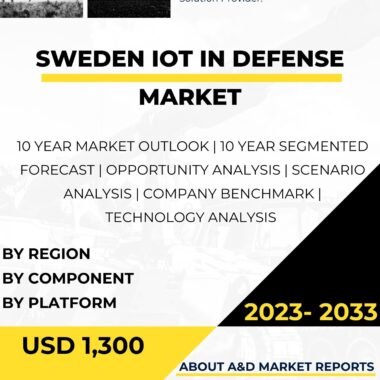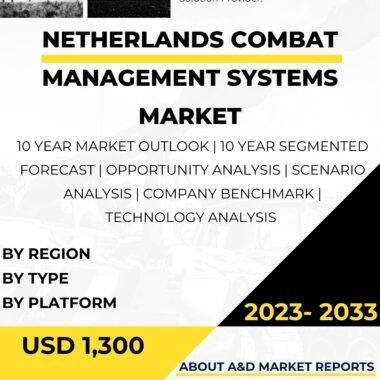Description
The Internet of Things (IoT) has become a transformative technology in various industries, and the defense sector is no exception. The South Korea IoT in defense market has witnessed significant growth as the country embraces IoT-based solutions to enhance military capabilities, improve operational efficiency, and strengthen national security. The integration of IoT technologies into defense systems offers numerous benefits, including real-time data monitoring, enhanced situational awareness, predictive maintenance, and optimized resource utilization. South Korea’s focus on indigenous development, strategic partnerships, and innovation has positioned it as a key player in the global IoT in defense market.
IoT in defense refers to the interconnected network of devices, sensors, and systems that enable data exchange and communication between various military assets. These assets can range from individual soldiers and weapons systems to vehicles, surveillance equipment, and infrastructure. By collecting and analyzing data in real-time, IoT in defense enhances decision-making capabilities and improves the overall effectiveness of military operations.
South Korea’s defense industry has actively embraced IoT technologies to address its unique security challenges and modernize its armed forces. Indigenous development has been a cornerstone of the country’s defense strategy, and the IoT in defense market is no exception. The South Korean defense companies, such as Hanwha Defense, LIG Nex1, and Samsung Techwin, have made significant progress in developing IoT-based solutions for military applications.
One area where IoT has seen substantial implementation is in soldier systems. IoT-enabled wearable devices provide individual soldiers with vital information about their own health, surroundings, and mission status. Biometric sensors, GPS tracking, and communication systems integrated into soldier wearables enhance their situational awareness and facilitate better coordination among units.
Moreover, South Korea has integrated IoT technologies into its military vehicles, including tanks, armored personnel carriers, and unmanned ground vehicles. IoT sensors and devices enable real-time monitoring of vehicle health, fuel consumption, and logistics requirements. This data-driven approach optimizes vehicle maintenance schedules, increases vehicle reliability, and reduces downtime.
In the domain of border security and surveillance, South Korea leverages IoT-enabled sensors and drones to monitor its borders and coastal areas. These sensors can detect intrusions, track suspicious activities, and provide early warnings in the event of security breaches. By combining IoT data with artificial intelligence (AI) and machine learning algorithms, the country can achieve an even higher level of automated threat detection and response.
Additionally, South Korea’s naval forces have also benefited from IoT integration. IoT sensors on naval vessels monitor the ship’s condition, engine performance, and fuel consumption. These real-time data streams allow for predictive maintenance, ensuring that critical systems are serviced before issues escalate, and enabling ships to stay operational for more extended periods.
Strategic partnerships with international defense companies have also played a crucial role in South Korea’s IoT in defense market. Collaborations with global technology leaders allow for the transfer of advanced IoT technologies, as well as the integration of foreign systems into South Korea’s defense infrastructure. These partnerships expand the country’s access to cutting-edge solutions and reinforce its position in the global defense IoT market.
South Korea’s commitment to innovation and R&D further strengthens its IoT in defense capabilities. Ongoing research efforts focus on developing more advanced IoT sensors, communication protocols, and data analytics tools that can handle large volumes of military data. The integration of AI and machine learning into IoT systems enhances the ability to detect anomalies, predict outcomes, and make informed decisions on the battlefield.
Cybersecurity is a critical consideration in the IoT in defense market. As connected devices and systems become more prevalent, the potential vulnerabilities and cyber threats increase. South Korea recognizes this challenge and invests in robust cybersecurity measures to protect its defense IoT infrastructure from cyber-attacks.
South Korea’s IoT in defense market is not limited to its domestic requirements. The country actively seeks opportunities to export its IoT-based defense solutions to other nations. Successful exports demonstrate the reliability and effectiveness of South Korean-made IoT technologies and contribute to the growth of its defense industry.
To ensure optimal utilization of IoT in defense systems, South Korea emphasizes training and skill development for its military personnel. Training programs focus on familiarizing personnel with IoT devices, data analysis, and secure communication protocols. Well-trained personnel are essential for maximizing the potential of IoT technologies and ensuring their effective use in military operations.
In conclusion, the South Korea IoT in defense market plays a crucial role in enhancing the country’s defense capabilities. Indigenous development, strategic partnerships, and innovation have allowed South Korea to create advanced IoT solutions that cater to the specific needs of its military. By leveraging IoT technologies, South Korea enhances its situational awareness, improves operational efficiency, and strengthens national security. As the defense industry continues to evolve, South Korea’s dedication to advancing its IoT in defense capabilities will remain essential in safeguarding its national interests and maintaining its position as a significant player in the global defense market.




